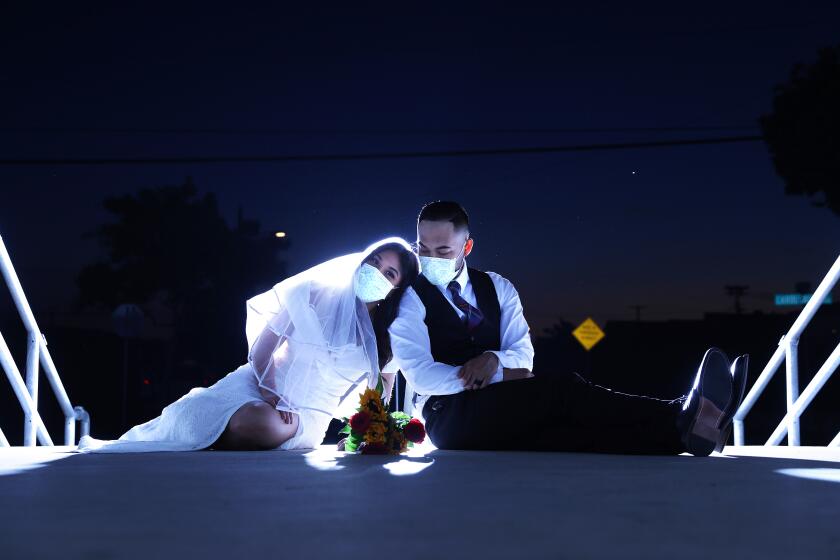Op-Ed: Why you should buy Microsoft instead of a wedding dress

It struck me as I stood in the bridal shop, looking at the flowing white dresses adorning the pink walls — the contradiction inherent in a wedding dress. It’s a once-in-a-lifetime gown that’s meant to flawlessly fit your body with perfect alignment to your taste and style. A wedding dress is supposed to embody originality, yet the billowing white gowns felt homogeneous. Identical.
By the time I looked at a price tag, I had already decided to say “no” to the dress. And “no” to the big wedding, with hold-the-date mailings, invite mailings, and a venue that has to be secured two years in advance with a $1,200 deposit.
This was pre-COVID-19, when the biggest wedding concerns were how to make it Instagram-worthy. Now the Centers for Disease Control and Prevention is advising canceling gatherings with more than 10 people. Weddings are being rescheduled or scrapped altogether as wedding planners wonder if this is the end of the statement-wedding era.
Please let it be so. Perhaps the pandemic and the need to quarantine will give society the time it needs to reexamine what a wedding should be. With luck, expensive, elaborate weddings will die out with the virus.
It takes enormous effort to arrange a big wedding — to find the perfect spot to say “I do,” to settle the guest list, the music, the food.
I was never one of those little girls who started planning her dream wedding in grade school. I never sat around envisioning how I wanted my wedding dress to look. But ever since I read my first investing book in high school, I’ve been keenly interested in how I wanted my finances to look. Once I became engaged and started reviewing wedding options that fit our humble budget, it only strengthened my long-held conviction: Weddings, at least the grand productions that have become increasingly popular, are a waste of money.
The average American wedding dress costs $1,631, according to Brides.com. Today I could buy eight shares of Microsoft with that money. If a bride bought eight shares of Microsoft 25 years ago with her money — instead of a wedding dress that she’d have to give to Goodwill because her daughter would never wear something so outdated — that investment would be worth about $26,000 now. Microsoft’s investment results calculator backs me up on this. Instead of a dress with a one-day lifespan, you could invest in “wedding stock” of your choosing.
If the cost of the dress doesn’t faze you, let’s look at the cost of an average U.S. wedding — almost $34,000 last year. Now consider that 70% of Americans have less than $1,000 in savings.
Sure, weddings create memories for a lifetime, but I also want to retire in my lifetime. Nobody should go into debt or experience financial hardship for one day of celebration.
The reality is that when many of us are planning weddings, we’re not flush with cash and statistics show neither are many of our parents. Almost 80% of Americans live paycheck to paycheck. That alone should inspire us as a society to take a good, hard look at what has become a wedding industrial complex.
After all, when the big day is over, what have you gained materially? Some wedding photos, one of which you’ll frame or use for a profile pic. Some gifts — a gravy boat, a waffle maker, five-piece porcelain place settings that’ll mostly stay in a cabinet. But you don’t have to throw a party that costs a fortune to receive wedding gifts from family and friends.
In a way, the pandemic is giving society a wedding gift. The sudden absence of enormous, over-the-top weddings is an opportunity for financial gain. You have been given permission to go your own way.
Couples and their parents don’t have to go broke on over-the-top venues and uninspired banquet food. Bridesmaids don’t have to spend money on a dress they may never wear again. Would-be guests don’t have to throw down hundreds of dollars for plane tickets and hotels.
If we remove the expectation of extravagance from the wedding equation, we can still invite family and friends — within reason. If you celebrate with 50 or even just 15 of them, will you really notice the absence of the 150 you left off the list? After all, the average American has 16 friends, according to a recent poll. Outside of our nuclear families, how many “family” members really need to be there?
One year after my bridal shop epiphany, I married my husband at the Los Angeles airport courthouse, with just the two of us and an officiant. Cost of the wedding: $90 for the marriage license. It was intimate and easy. And the money we saved offset the cost of trips we took to honeymoon in Aruba and visit family later that year.
We’ve been married five years, and I occasionally long for the wedding I never had. When I look at my investment portfolio, those feelings always go away.
Amber Petrovich creates content about investing and the wealth gap on TikTok and YouTube.
More to Read
A cure for the common opinion
Get thought-provoking perspectives with our weekly newsletter.
You may occasionally receive promotional content from the Los Angeles Times.











